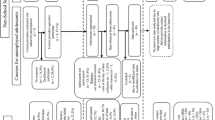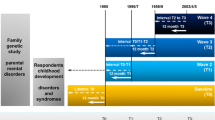Abstract
Objective
This prospective longitudinal study of a representative community sample of children and adolescents (N = 269) examined the long-term course and predictive power of psychiatric symptoms in childhood/adolescence for diagnostic outcome (ICD-10) 18 years later at adult age.
Method
At both cross-sectional assessments, baseline (1980–1984) and the 18-year follow-up (2001–2004), psychiatric symptoms were assessed using the ‘Standardized Psychiatric Interview’ (Goldberg et al. in Br J Prev Soc Med 24:18–23, 1970). At follow-up, study participants were reassessed with the standardized M-CIDI (Wittchen and Pfister in Manual und Durchführungsbeschreibung des DIA-X-M-CIDI, Swets and Zeitlinger, Frankfurt, 1997) interview.
Results
The participation rate at 18-year follow-up was 82% of those alive. The frequency of clinically relevant depressive symptoms and symptoms of anxiety or phobia was considerably higher when the participants were younger (baseline assessment at childhood, adolescent age) as compared to their scores in adult age. Increased levels of somatic symptoms, fatigue, irritability, sleep disturbances, depression, anxiety and worry as well as phobic symptoms in childhood/adolescence were related to a higher risk of suffering from a psychiatric disorder in adulthood. Depressive symptoms predicted both mood disorders and substance use disorders in adulthood. Phobias predicted later anxiety disorders.
Conclusion
These data spanning almost two decades add significant information to the existing literature on the course of mental disorders in the community during the transition from adolescence to adulthood.

Similar content being viewed by others
Notes
All data presented here are from the baseline assessment or from the 18-year follow up. In addition a cross-sectional assessment with limited number of instruments was performed in the mid-1970 s [13] but data are not considered here except the variables “mother completed vocational training” and “mental disturbance in other family members.”
Due to the fact that the first wave of the longitudinal study was assessed in the late 1970’s the SPI-Interview developed by Goldberg et al. [19] was used at all three cross-sections; the diagnostic interview schedule (DIS) was not yet available at the beginning of the study.
This interview should not be confused with the ‘General Health Questionnaire’ (GHQ) also published by David Goldberg.
References
Achenbach TM, Howell CT, McConaughy SH, Stanger C (1995) Six-year predictors of problems in a national sample of children and youth: I. Cross-informant syndromes. J Am Acad Child Adolesc Psychiatry 34:336–347
Angst J, Merikangas KR, Preisig M (1997) Subthreshold syndromes of depression and anxiety in the community. J Clin Psychiatry 8(Suppl 58):6–10
Birmaher B, Ryan ND, Williamson DE, Brent DA, Kaufman J, Dahl RE, Perel J, Nelson B (1996) Childhood and adolescent depression: a review of the past 10 years. Part I. J Am Acad Child Adolesc Psychiatry 35:1427–1439
Caspi A, Moffitt TE, Newman DL, Silva PA (1996) Behavioral observations at age 3 years predict adult psychiatric disorders. Longitudinal evidence from a birth cohort. Arch Gen Psychiatry 53:1033–1039
Cohen J (1960) A coefficient of agreement for nominal scales. Educ Psychol Measur 20:37–46
Colman I, Wadsworth MEJ, Croudace TJ, Jones PB (2007) Forty-year psychiatric outcomes following assessment for internalizing disorder in adolescence. Am J Psychiatry 164:126–133
Colman I, Ploubidis GB, Wadsworth MEJ, Jones PB, Croudace TJ (2007) A longitudinal typology of symptoms of depression and anxiety over the life course. Biol Psychiatry 62:1265–1271
Costello A, Edelbrock C, Kalas R, Kessler M, Klaric S (1982) National Institute of Mental Health Diagnostic Interview Schedule for Children. National Institute of Mental Health, Rockville
Costello EJ, Edelbrock CS, Costello AJ (1985) Validity of the NIMH diagnostic interview schedule for children: a comparison between psychiatric and pediatric referrals. J Abnorm Child Psychol 13(4):579–595
Costello EJ, Angold A, Keeler GP (1999) Adolescent outcomes of childhood disorders: the consequences of severity and impairment. J Am Acad Child Adolesc Psychiatry 38:121–128
Crawford TN, Cohen P, First MB, Skodol AE, Johnson JG, Kasen S (2008) Comorbid axis I and axis II disorders in early adolescence. Outcomes 20 years later. Arch Gen Psychiatry 65:641–648
Crum RM, Green KM, Storr CL, Chan YF, Ialongo N, Stuart EA, Anthony JC (2008) Depressed mood in childhood and subsequent alcohol use through adolescence and young adulthood. Arch Gen Psychiatry 65:702–712
Dilling H, Weyerer S (1984) Psychische Erkrankungen in der Bevölkerung bei Erwachsenen und Jugendlichen. In: Dilling H, Weyerer S, Castell R (eds) Psychische Erkrankungen in der Bevölkerung. Enke Verlag, Stuttgart
Esser G, Schmidt MH, Blanz B, Fatkenheuer B, Fritz A, Koppe T, Laucht M, Rensch B, Rothenberger W (1992) Prevalence and course of psychiatric disorders in childhood and adolescence. Results of a prospective longitudinal epidemiological study from age 8 to 18. Z Kinder Jugendpsychiatr 20:232–242
Esser G, Ihle W, Schmidt MH, Blanz B (2000) Der Verlauf psychischer Störungen vom Kindes- zum Erwachsenenalter. Z Klin Psychol Psychother 29:276–283
Ferdinand RF, Verhulst FC (1995) Psychopathology from adolescence into young adulthood: an 8-year follow-up study. Am J Psychiatry 152:1586–1594
Fergusson DM, Horwood LJ, Ridder EM, Beautrais AL (2005) Subthreshold depression in adolescence and mental health outcomes in adulthood. Arch Gen Psychiatry 62:66–72
First MB, Gibbon M, Spitzer RL (1996) User’s guide for the SCID-I structured clinical interview for DSM-IV (SCID-I Version 2.0, February 1996 Final Version). Biometrics Research Department, New York State Psychiatric Institute, 722 West, 168th Street, New York, NY 10032
Goldberg DP, Cooper P, Eastwood RR, Kedward MB, Shepherd M (1970) A standardized psychiatric interview for use in community surveys. Br J Prev Soc Med 24:18–23
Goodwin RD, Fergusson DM, Horwood LJ (2004) Association between anxiety disorders and substance use disorders among young persons: results of a 21-year longitudinal study. J Psychiatr Res 38:295–304
Hankin BL, Abramson LY, Moffitt TE, Silva PA, McGee R, Angell KE (1998) Development of depression from preadolescence to young adulthood: emerging gender differences in a 10-year longitudinal study. J Abnorm Psychol 107(1):128–141
Harrington R, Fudge H, Rutter M, Pickles A, Hill J (1990) Adult outcomes of childhood and adolescent depression. I. Psychiatric status. Arch Gen Psychiatry 47:465–473
Harrington R, Rutter M, Fombonne E (1996) Developmental pathways in depression: multiple meanings, antecedents, and endpoints. Dev Psychopathol 8:601–616
Hofstra MB, Van der Ende J, Verhulst FC (2000) Continuity and change of psychopathology from childhood into adulthood: a 14-year follow-up study. J Am Acad Child Adolesc Psychiatry 39:850–858
Hofstra MB, Van der Ende J, Verhulst FC (2002) Child and adolescent problems predict DSM-IV disorders in adulthood: a 14-year follow-up of a Dutch epidemiological sample. J Am Acad Child Adolesc Psychiatr 41:182–189
Kessler RC, McGonagle KA, Zhao S, Nelson CB, Hughes M, Eshleman S, Wittchen HU, Kendler KS (1994) Lifetime and 12-month prevalence of DSM-III-R psychiatric disorders in the United States. Results from the national comorbidity survey. Arch Gen Psychiatry 51(1):8–19
Kessler RC, Demler O, Frank RG, Olfson M, Pincus HA, Walters EE, Wang PS, Wells KB, Zaslavsky AM (2005) Prevalence and treatment of mental disorders, 1990 to 2003. N Engl J Med 352:2515–2523
Kim-Cohen J, Caspi A, Moffitt TE, Harrington H, Milne BJ, Poulton R (2003) Prior juvenile diagnoses in adults with mental disorder: developmental follow-back of a prospective-longitudinal cohort. Arch Gen Psychiatry 60:709–717
Kleining G, Moore H (1968) Soziale Selbsteinstufung (SSE). Ein Instrument zur Messung sozialer Schichten. Köln Z Soziol Sozialpsychol 20:502–552
Lewinsohn PM, Rohde P, Klein DN, Seeley JR (1999) Natural course of adolescent major depressive disorder: I. Continuity into young adulthood. J Am Acad Child Adolesc Psychiatry 38:56–63
Lewinsohn PM, Solomon A, Seeley JR, Zeiss A (2000) Clinical implications of “subthreshold” depressive symptoms. J Abnorm Psychol 109(2):345–351
Maughan B, Kim-Cohen J (2005) Continuities between childhood and adult life. Br J Psychiatry 187:301–303
Merikangas KR, Zhang H, Avenevoli S, Acharyya S, Neuenschwander M, Angst J (2003) Longitudinal trajectories of depression and anxiety in a prospective community study. Arch Gen Psychiatry 60:993–1000
Newman DL, Moffitt TE, Caspi A, Magdol L, Silva PA, Stanton WR (1996) Psychiatric disorder in a birth cohort of young adults: prevalence, comorbidity, clinical significance, and new case incidence from ages 11 to 21. J Consult Clin Psychol 64:552–562
Pine DS, Cohen P, Gurley D, Brook J, Yl Ma (1998) The risk for early-adulthood anxiety and depressive disorders in adolescents with anxiety and depressive disorders. Arch Gen Psychiatry 55:56–64
Pine DS, Cohen P, Brook J (2001) Adolescent fears as predictors of depression. Biol Psychiatry 50:721–724
Robins LN, Wing J, Wittchen HU, Helzer JE, Babor TF, Burke J, Farmer A, Jablensky A, Pickens R, Regier DA, Sartorius N, Towle LH (1989) The composite international diagnostic interview: an epidemiologic instrument suitable for use in conjunction with different diagnostic systems and in different cultures. Arch Gen Psychiatry 45:1069–1077
Robins LN, Regier DA (1991) Psychiatric disorders in America: The epidemiological catchment area study. Free Press, New York
Roza S, Hofstra M, van der Ende J, Verhulst F (2003) Stable prediction of mood and anxiety disorders based on behavioral and emotional problems in childhood: a 14-year follow-up during childhood, adolescence, and young adulthood. Am J Psychiatry 160:2116–2121
Rutter M, Shaffer D, Sturge C (1975) A guide to a multi-axial classification scheme for psychiatric disorders in childhood and adolesence. Institute of Psychiatry, London
Rutter M, Caspi A, Moffitt TE (2003) Using sex differences in psychopathology to study causal mechanisms: unifying issues and research strategies. J Child Psychol Psychiatry 44(8):1092–1115
Rutter M, Kim-Cohen J, Maughan B (2006) Continuities and discontinuities in psychopathology between childhood and adult life. J Child Psychol Psychiatry 47:276–295
Weissman MM, Klerman GL (1977) Sex differences and the epidemiology of depression. Arch Gen Psychiatry 34(1):98–111
Weyerer S, Castell R, Biener A, Artner K, Dilling H (1988) Prevalence and treatment of psychiatric disorders in 3 to 14-year-old children: results of a representative field study in the small town rural region of Traunstein, Upper Bavaria. Acta Psychiatr Scand 77:290–296
Wittchen HU, Pfister H (1997) Manual und Durchführungsbeschreibung des DIA-X-M-CIDI. Swets and Zeitlinger, Frankfurt
Wittchen HU, Kessler RC, Pfister H, Lieb M (2000) Why do people with anxiety disorders become depressed? A prospective-longitudinal community study. Acta Psychiatr Scand 102(Suppl 406):14–23
World Health Organization (1992) The ICD-10 classification of mental and behavioural disorders: clinical description and diagnostic guidelines. World Health Organization, Geneva
Acknowledgments
This research was funded by the Deutsche Forschungsgemeinschaft, Bonn, Germany, grant number Fi 333/4-1, Fi 333/4-2. We especially thank Dipl.-Psych. Eva Bolz, Dr. Marian Cebulla, Dipl.-Psych. Helen Castellanos, Dipl.-Psych. Andrea Dusold, Dipl.-Psych. Andreas Hampel, Dr. Gabriele Kohlböck, Dr. Thomas Niedermeier, Dipl.-Psych. Birgit Schaider, Dipl.-Psych. Nicole Sevignani and Dipl.-Psych. Nadia Sosnowsky for their sensitive way of conducting interviews with the participants of the 18-year follow-up. We also thank Susanne Hedlund (PhD) for helping to improve the formulation of this manuscript and the editor and reviewers who helped to improve the quality of the paper.
Author information
Authors and Affiliations
Corresponding author
Rights and permissions
About this article
Cite this article
Fichter, M.M., Kohlboeck, G., Quadflieg, N. et al. From childhood to adult age: 18-year longitudinal results and prediction of the course of mental disorders in the community. Soc Psychiat Epidemiol 44, 792–803 (2009). https://doi.org/10.1007/s00127-009-0501-y
Received:
Revised:
Published:
Issue Date:
DOI: https://doi.org/10.1007/s00127-009-0501-y




